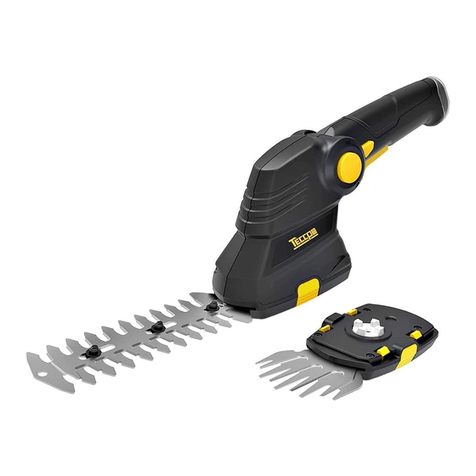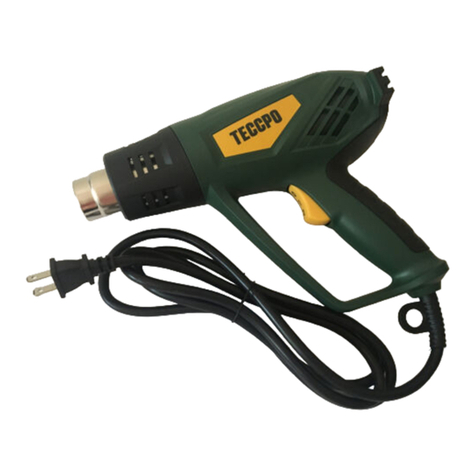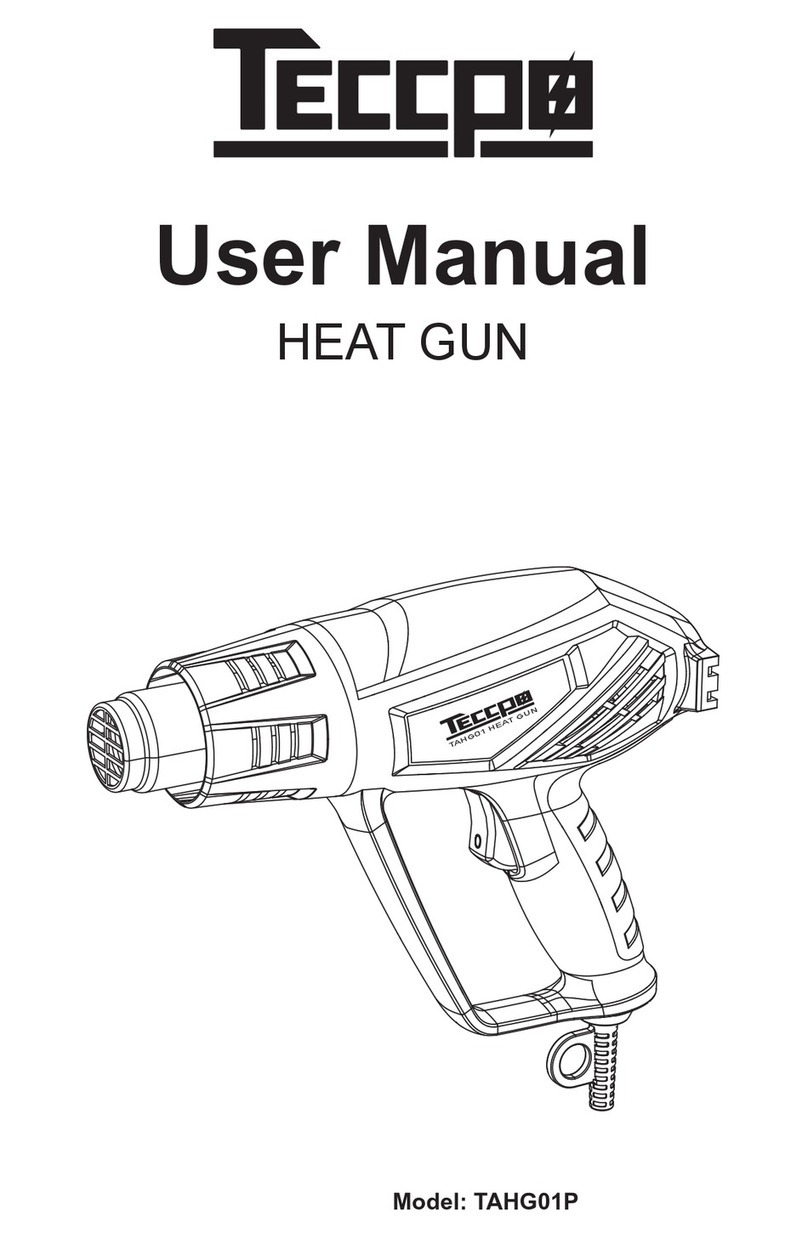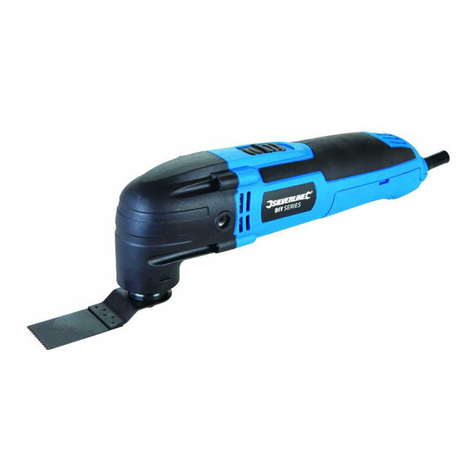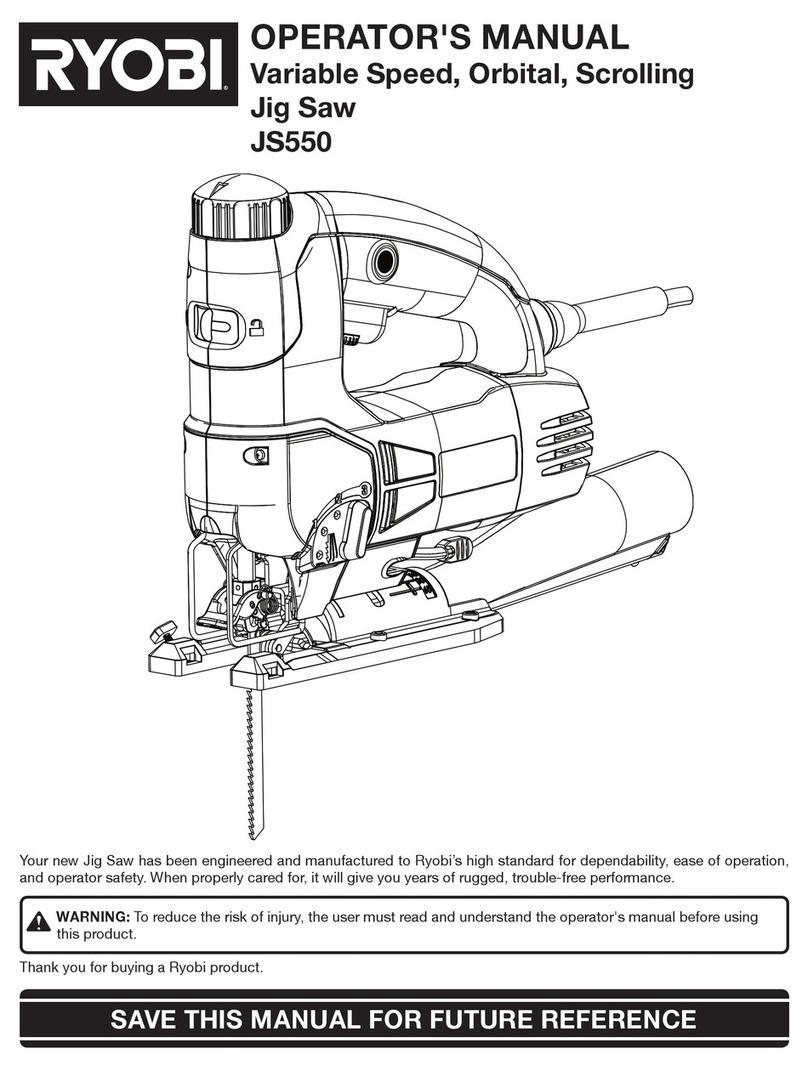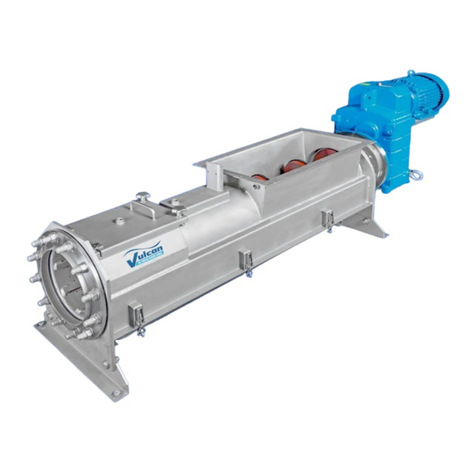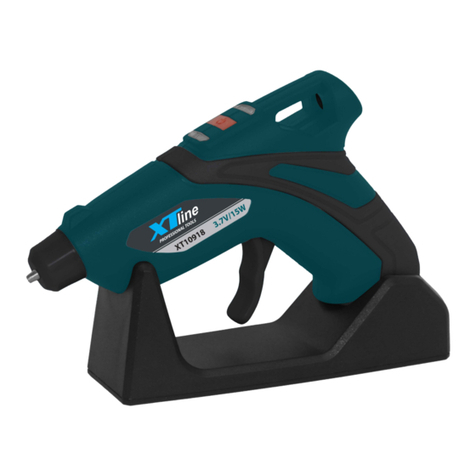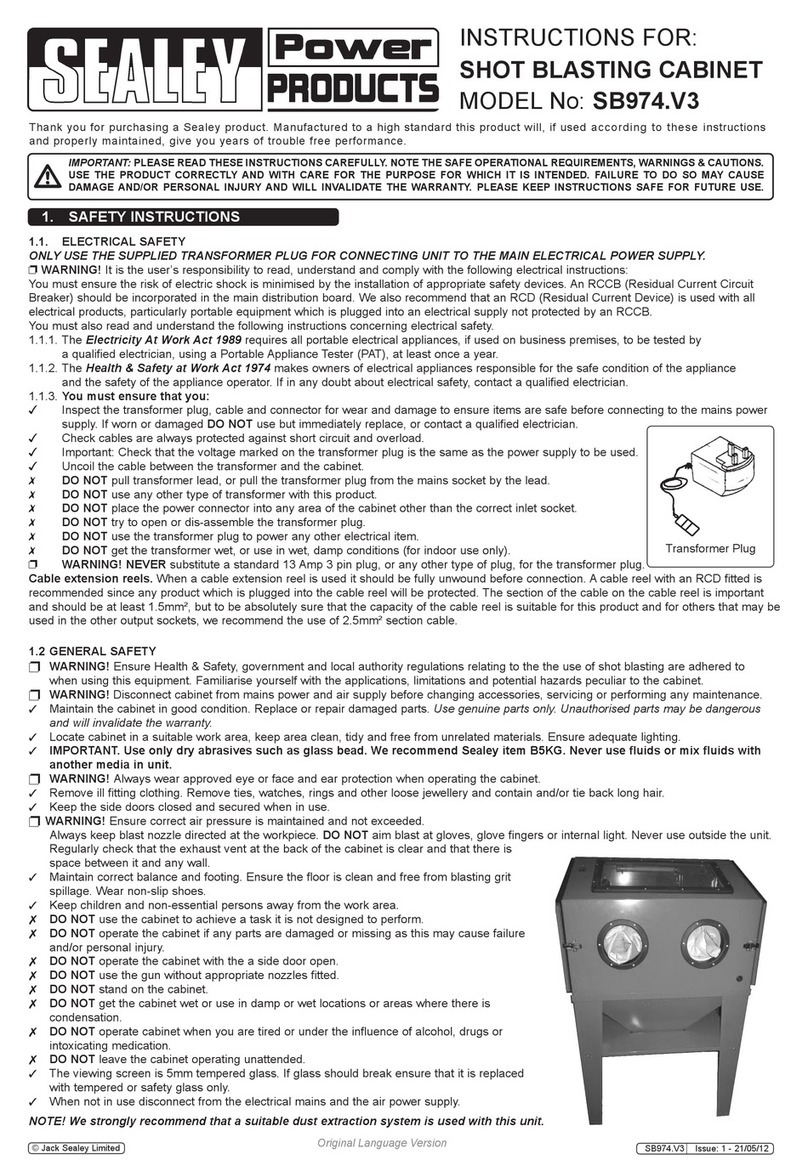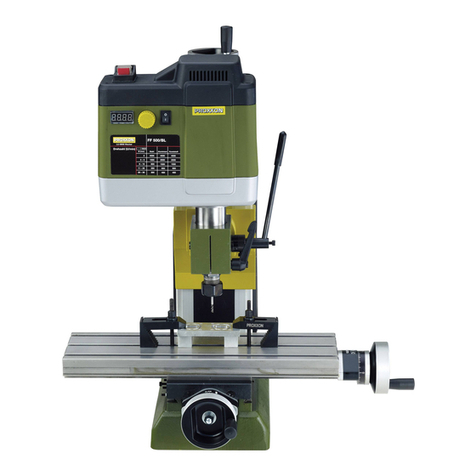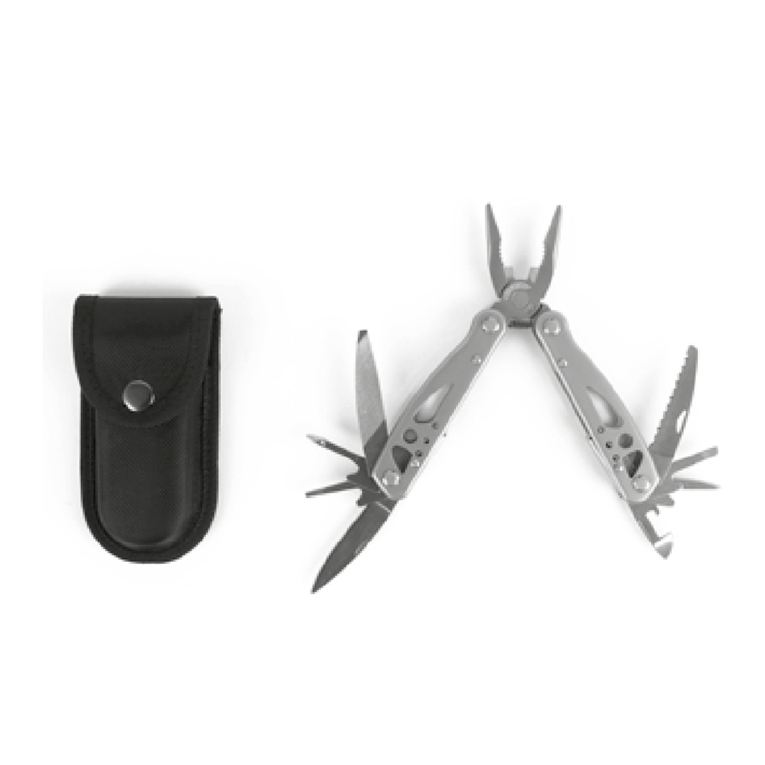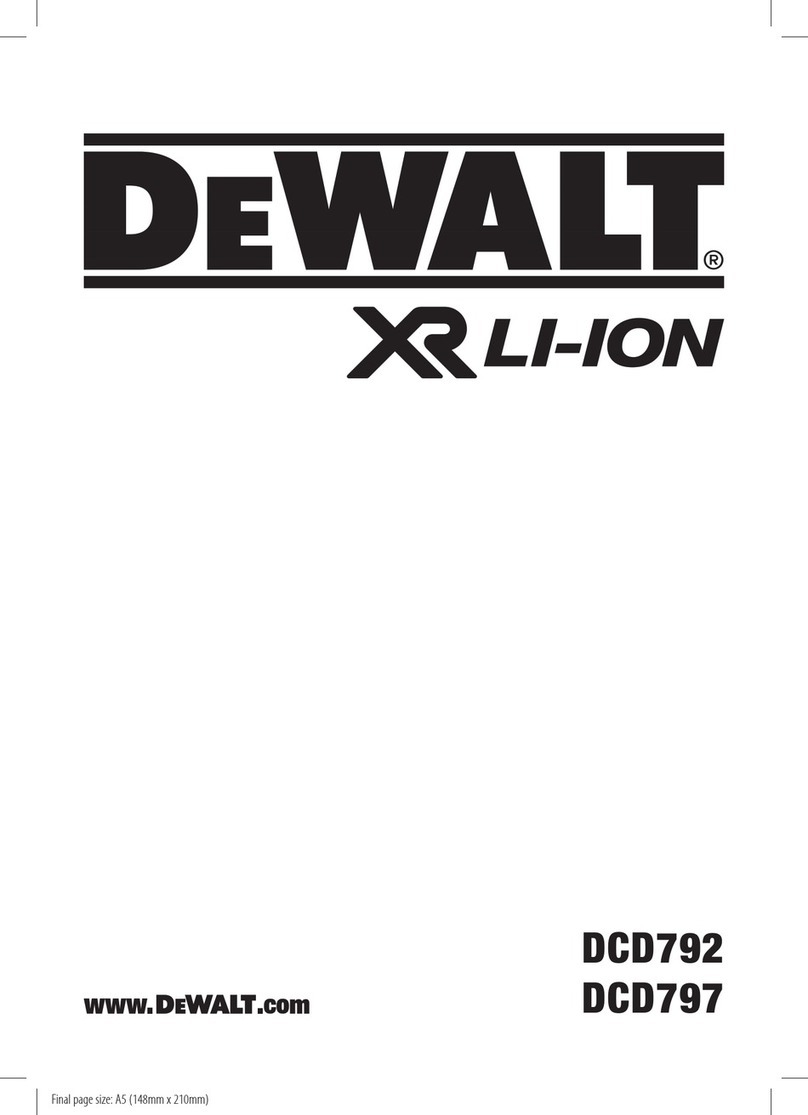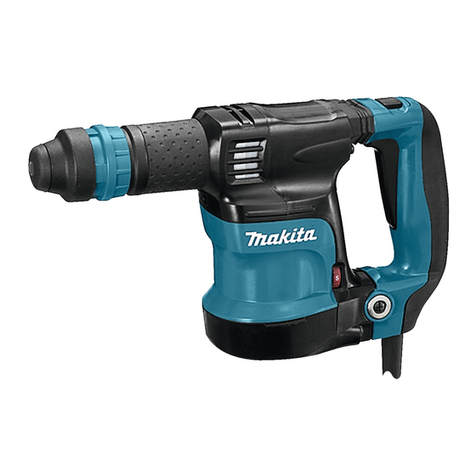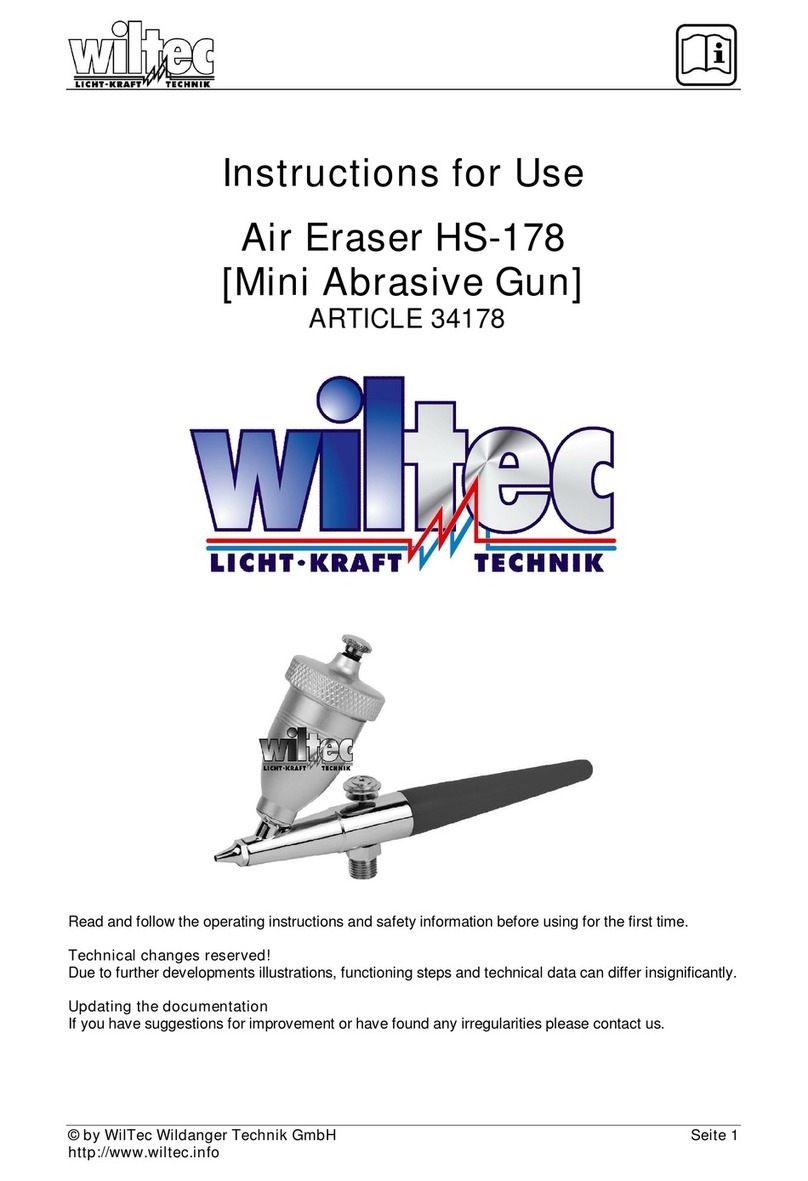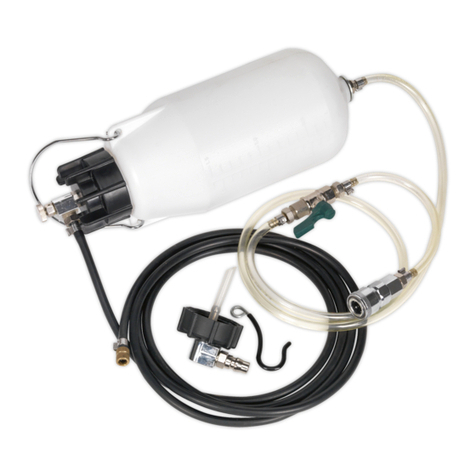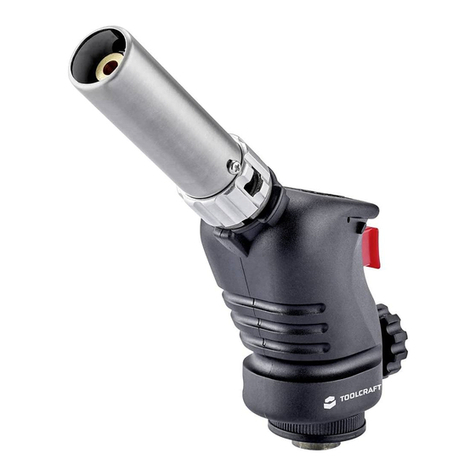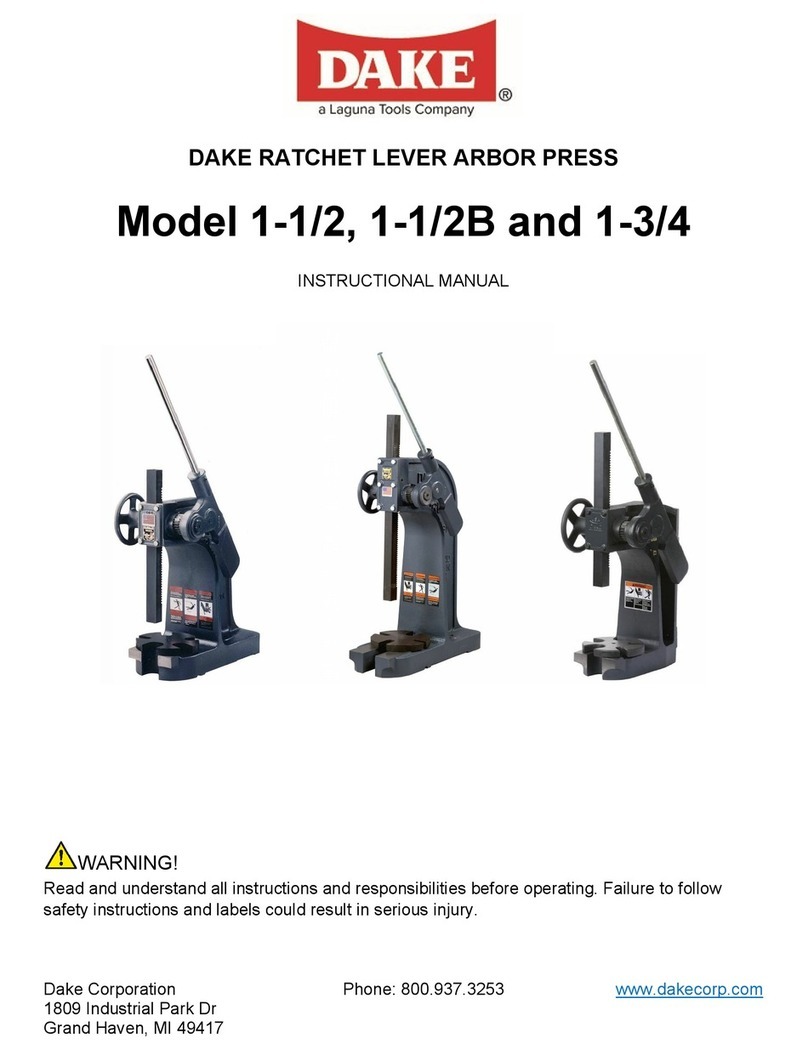Teccpo TART04P User manual

Advanced Rotary Tool
Model: TART04P
User Manual
TECCPO is committed to providing the best After-sale Service, we strive
for your FIVE STAR satisfaction!

Safety instructions
Save all warnings and instructions for future reference.
1)
a)
b)
c)
2)
a)
b)
c)
d)
e)
3)
a)
b)
c)
d)
e)
Work area safety
Keep work area clean and well lit. Cluttered or dark areas invite accidents.
Donotoperatepower toolsin explosiveatmospheres, suchas inthe presence
of flammable liquids, gases or dust. Power tools create sparks which may
ignite the dust or fumes.
Keep children and bystanders away while operating a power tool. Distractions
can cause you to lose control.
Electrical safety
Power tool plugs must match the outlet. Never modify the plug in any way.
Donot useany adapterplugs withearthed (grounded)power tools.Unmodified
plugs and matching outlets will reduce risk of electric shock.
Avoid body contact with earthed or grounded surfaces such as pipes, radiators,
ranges and refrigerators. There is an increased risk of electric shock if
your body is earthed or grounded.
Do not expose power tools to rain or wet conditions. Water entering a power
tool will increase the risk of electric shock.
Do not abuse the cord. Never use the cord for carrying, pulling or unplugging
the power tool. Keep cord away from heat, oil, sharp edges or moving parts.
Damaged or entangled cords increase the risk of electric shock.
When operating a power tool outdoors, use an extension cord suitable for
outdoor use, with which reduces the risk of electric shock.
Personal safety
Stay alert, watch what you are doing and use common sense when operating
a power tool. Do not use a power tool while you are tired or under the influence
of drugs, alcohol or medication.Amoment of inattention while operating power
tools may result in serious personal injury.
Use personal protective equipment.Always wear eye protection. Protective
equipment such as dust mask, non-skid safety shoes, hard hat, or hearing
protection used for appropriate conditions will reduce personal injuries.
Prevent unintentional starting. Ensure the switch is in the off-position before
connecting to a power source and / or battery pack, picking up or carrying
the tool. Carrying power tools with your finger on the switch or energizing
power tools that have the switch on invites accidents.
Remove any adjusting key or wrench before turning the power tool on. A
wrench or a key left attached to a rotating part of the power tool may result
in personal injury.
Do not overreach. Keep proper footing and balance at all times. This enables
Warning: read all safety warnings and all instructions. Failure to
follow the warnings and instructions may result in electric shock, fire
and / or serious injury.
- 01 -

- 02 -
f)
g)
4)
a)
b)
c)
d)
e)
f)
g)
5)
a)
Safety instructions for all operations
Safety warnings common for grinding, sanding, wire brushing, polishing, carving
or abrasive cutting-off operations:
a)
better control of the power tool in unexpected situations.
Dress properly. Do not wear loose clothing or jewelry. Keep your hair,
clothing and gloves away from moving parts. Loose clothes, jewellery or
long hair can be caught in moving parts.
If devices are provided for the connection of dust extraction and collection
facilities, ensure these are connected and properly used. Use of these
devices can reduce dust-related hazards.
Power tool use and care
Do not force the power tool. Use the correct power tool for your application.
The correct power tool will do the job better and safer at the rate for which
it was designed.
Do not use the power tool if the switch does not turn it on and off. Any
power tool that cannot be controlled by the switch is dangerous and must
be repaired.
Disconnect the plug from the power source and / or the battery pack from
the power tool before making any adjustments, changing accessories, or
storing power tools. Such preventive safety measures reduce the risk of
starting the power tool accidentally.
Store idle power tools out of the reach of children and do not allow persons
unfamiliar with the power tool or these instructions to operate the power
tool. Power tools are dangerous in the hands of untrained users.
Maintain power tools. Check for misalignment or binding of moving parts,
breakage of parts and any other condition that may affect the power tools
operation. If damaged, have the power tool repaired before use. Many
accidents are caused by poorly maintained power tools.
Keep cutting tools sharp and clean. Properly maintained cutting tools with
sharp cutting edges are less likely to bind and are easier to control.
Use the power tool, accessories and tool bits etc. In accordance with these
instructions and in the manner intended for the particular type of power tool,
taking into account the working conditions and the work to be performed.
Use of the power tool for operations different from those intended could result
in a hazardous situation.
Service
Have your power tool serviced by a qualified repair person using only
identical replacement parts. This will ensure that the safety of the power
tool is maintained.
This power tool is intended to function as a grinder, sander, wire brush,
polisher, carving or cut-off tool. Read all safety warnings, instructions,
illustrations and specifications provided with this power tool. Failure to
follow all instructions listed below may result in electric shock, fire and /

- 03 -
b)
c)
d)
e)
f)
g)
h)
i)
j)
or serious injury.
NOTE List only those operations that are applicable.
NOTE List only those operations that were not included in the first warning.
If all listed operations are applicable, then this warning is omitted, but all
subsequent warnings are given without exclusion.
Do not use accessories which are not specifically designed and recommended
by the tool manufacturer. Just because the accessory can be attached to
your power tool, it does not assure safe operation.
The rated speed of the grinding accessories must be at least equal to the
maximum speed marked on the power tool. Grinding accessories running
faster than their rated speed can break and fly apart.
The outside diameter and the thickness of your accessory must be within
the capacity rating of your power tool. Incorrectly sized accessories cannot
be adequately controlled.
The arbour size of wheels, sanding drums or any other accessory must
properly fit the spindle or collet of the power tool.Accessories that do not
match the mounting hardware of the power tool will run out of balance,
vibrate excessively and may cause loss of control.
Mandrel mounted wheels, sanding drums, cutters or other accessories
must be fully inserted into the collet or chuck. If the mandrel is insufficiently
held and / or the overhang of the wheel is too long, the mounted wheel
may become loose and be ejected at high velocity.
Do not use a damaged accessory. Before each use inspect the accessory
such as abrasive wheels for chips and cracks, sanding drum for cracks,
tear or excess wear, wire brush for loose or cracked wires. If power tool
or accessory is dropped, inspect for damage or install an undamaged
accessory.After inspecting and installing an accessory, position yourself
and bystanders away from the plane of the rotating accessory and run
the power tool at maximum no-load speed for one minute.
Damaged accessories will normally break apart during this test time.
Wear personal protective equipment. Depending on application, use face
shield, safety goggles or safety glasses. As appropriate, wear dust mask,
hearing protectors, gloves and workshop apron capable of stopping
small abrasive or workpiece fragments. The eye protection must be
capable of stopping flying debris generated by various operations. The
dust mask or respirator must be capable of filtrating particles generated
by your operation. Prolonged exposure to high intensity noise may cause
hearing loss.
Keep bystanders a safe distance away from work area.Anyone entering
the work area must wear personal protective equipment. Fragments of
workpiece or of a broken accessory may fly away and cause injury beyond
immediate area of operation.
Hold power tool by insulated gripping surfaces only, when performing an
operation where the cutting accessory may contact hidden wiring or its
own cord. Cutting accessory contacting a "live" wire may make exposed

- 04 -
k)
l)
m)
n)
o)
p)
q)
r)
s)
Further safety instructions for all operations
Kickback and related warnings
Kickback is a sudden reaction to a pinched or snagged rotating wheel, sanding
band, brush or any other accessory. Pinching or snagging causes rapid stalling
of the rotating accessory which in turn causes the uncontrolled power tool to
be forced in the direction opposite of the accessory’s rotation.
For example, if an abrasive wheel is snagged or pinched by the workpiece,
the edge of the wheel that is entering into the pinch point can dig into the
surface of the material causing the wheel to climb out or kick out. The wheel
may either jump toward or away from the operator, depending on direction of
the wheel’s movement at the point of pinching. Abrasive wheels may also
break under these conditions.
Kickback is the result of power tool misuse and/or incorrect operating proce-
metal parts of the power tool "live" and could give the operator an
electric shock.
Always hold the tool firmly in your hand(s) during the start-up. The reac-
tion torque of the motor, as it accelerates to full speed, can cause the
tool to twist.
Use clamps to support workpiece whenever practical. Never hold a
small workpiece in one hand and the tool in the other hand while in use.
Clamping a small workpiece allows you to use your hand(s) to control the
tool. Round material such as dowel rods, pipes or tubing have a tendency
to roll while being cut, and may cause the bit to bind or jump toward you.
Position the cord clear of the spinning accessory. If you lose control, the
cord may be cut or snagged and your hand or arm may be pulled into
the spinning accessory.
Never lay the power tool down until the accessory has come to a complete
stop. The spinning accessory may grab the surface and pull the power tool
out of your control.
After changing the bits or making any adjustments, make sure the collet
nut, chuck or any other adjustment devices are securely tightened. Loose
adjustment devices can unexpectedly shift, causing loss of control, loose
rotating components will be violently thrown.
Do not run the power tool while carrying it at your side.Accidental contact
with the spinning accessory could snag your clothing, pulling the accessory
into your body.
Regularly clean the power tool’s air vents. The motor’s fan will draw the
dust inside the housing and excessive accumulation of powdered metal
may cause electrical hazards.
Do not operate the power tool near flammable materials. Sparks could
ignite these materials.
Do not use accessories that require liquid coolants. Using water or other
liquid coolants may result in electrocution or shock

- 05 -
dures or conditions and can be avoided by taking proper precautions as
given below.
a)
b)
c)
d)
e)
Additional safety instructions for grinding and cutting-off operations
Safety warnings specific for grinding and abrasive cutting-off operations:
a)
b)
c)
d)
e)
Maintain a firm grip on the power tool and position your body and arm
to allow you to resist kickback forces. The operator can control kickback
forces, if proper precautions are taken.
Use special care when working corners, sharp edges etc.Avoid bouncing
and snagging the accessory. Corners, sharp edges or bouncing have a
tendency to snag the rotating accessory and cause loss of control or
kickback.
Do not attach a toothed saw blade. Such blades create frequent kickback
and loss of control.
Always feed the bit into the material in the same direction as the cutting
edge is exiting from the material (which is the same direction as the chips
are thrown). Feeding the tool in the wrong direction causes the cutting
edge of the bit to climb out of the work and pull the tool in the direction
of this feed.
When using rotary files, cut-off wheels, high-speed cutters or tungsten
carbide cutters, always have the work securely clamped. These wheels will
grab if they become slightly canted in the groove, and can kickback. When
a cut-off wheel grabs, the wheel itself usually breaks. When a rotary file,
high-speed cutter or tungsten carbide cutter grabs, it may jump from the
groove and you could lose control of the tool.
Use only wheel types that are recommended for your power tool and
only for recommended applications. For example: do not grind with the
side of a cut-off wheel.Abrasive cut-off wheels are intended for peripheral
grinding, side forces applied to these wheels may cause them to shatter.
For threaded abrasive cones and plugs use only undamaged wheel
mandrels with an unrelieved shoulder flange that are of correct size and
length. Proper mandrels will reduce the possibility of breakage.
Do not “jam” a cut-off wheel or apply excessive pressure. Do not attempt
to make an excessive depth of cut. Overstressing the wheel increases
the loading and susceptibility to twisting or snagging of the wheel in the
cut and the possibility of kickback or wheel breakage.
Do not position your hand in line with and behind the rotating wheel.
When the wheel, at the point of operation, is moving away from your
hand, the possible kickback may propel the spinning wheel and the
power tool directly at you.
When wheel is pinched, snagged or when interrupting a cut for any
reason, switch off the power tool and hold the power tool motionless
until the wheel comes to a complete stop. Never attempt to remove the
cut-off wheel from the cut while the wheel is in motion otherwise
kickback may occur. Investigate and take corrective action to eliminate
the cause of wheel pinching or snagging.

f)
g)
h)
Additional safety instructions for wire brushing operations
Safety warnings specific for wire brushing operations:
a)
b)
c)
TECHNICAL SPECIFICATIONS
Mains voltage: 100-120V ~ 50/60 Hz
Power input: 1.5A
No load speed: 10,000 - 35,000 rpm
Collet: maxø3.2mm
Protection class: II / ഔ
Applications
You may use this product for the purposes listed below:
Ɣ
Ɣ
WARNING
Always wear eye protection when using this tool. Failure to do that
could result in objects being thrown into your eyes and cause possible
serious injury.
WARNING
Do not use any attachments or accessories not recommended by the
manufacturer of this product. The use of attachments or accessories
not recommended can result in serious personal injury.
- 06 -
Do not restart the cutting operation in the workpiece. Let the wheel reach
full speed and carefully re-enter the cut. The wheel may bind, walk up
or kickback if the power tool is restarted in the workpiece.
Support panels or any oversized workpiece to minimize the risk of
wheel pinching and kickback. Large workpieces tend to sag under their
own weight. Supports must be placed under the workpiece near the line
of cut and near the edge of the workpiece on both sides of the wheel.
Use extra caution when making a “pocket cut” into existing walls or
other blind areas. The protruding wheel may cut gas or water pipes,
electrical wiring or objects that can cause kickback.
Be aware that wire bristles are thrown by the brush even during ordinary
operation. Do not overstress the wires by applying excessive load to
the brush. The wire bristles can easily penetrate light clothing and / or
skin.
Allow brushes to run at operating speed for at least one minute before
using them. During this time no one is to stand in front or in line with the
brush. Loose bristles or wires will be discharged during the run-in time.
Direct the discharge of the spinning wire brush away from you. Small
particles and tiny wire fragments may be discharged at high velocity
during the use of these brushes and may become imbedded in your
skin.
Cutting
Sanding
Mains voltage:

Polishing and buffing
Engraving
Drilling
- 07 -
PART
A
B
C
D
E
F
G
H
I
J
DESCRIPTION
Shaft lock button
Housing cap
Collet
Collet nut
Collet wrench
Brush cap
On / Off switch
Speed control dial
Tool hanger
Power cord
A
F
FG
HI
J
B
C
D
E
Ɣ
Ɣ
Ɣ
Know Your Rotary Tool
Before attempting to use any tool, familiarize yourself with all operating features
and safety requirements.See Fig. 1.

WARNING
Do not press the shaft lock button (A) while rotary tool is running.
- 08 -
Replacing Collets
Using collets is the most precise way to hold an accessory in a high speed
rotating. Evenathighspeedsandmaximumpressure, collets stay tight.
ƒ
ƒ
ƒ
ƒ
ƒ
ƒ
Installing Accessories
ƒ
ƒ
ƒ
Functions Description
On / Off Switch
This product has an easy access power
switch (G) located at the bottom of the tool.
To turn the tool ON, push the ON/OFF (I / O)
switch (G) to the ON (I) position.
To turn the tool OFF, push the ON/OFF (I / O)
switch (G) to OFF (O) position.
G
Unplug the rotary tool.
Press and hold the shaft lock button(A), and rotate the shaft with
the provided collet wrench (E) until the shaft lock (A) engages
the shaft, preventing further rotation.
With the shaft lock (A) engaged, use the collet wrench (E) to loosen the
collet nut (D), if necessary.
Remove the collet nut (D) and old collet (C) using collet wrench (E),
if necessary.
Insert the unslotted end of the new collet (C) in the hole in the end of the
tool shaft.
Tighten the collet nut with the collet wrench (E)
Unplug the rotary tool.
Press and hold the shaft lock button(A), and rotate the shaft by hand until
the shaft lock engages the shaft, preventing further
rotation.
With the shaft lock button engaged, use the collet wrench (E) to loosen
the collet nut (D), if necessary.
A
E
D
C
AD

Unplug the rotary tool
Install the mandrel.
Press and hold the shaft lock button (A).
Insert the slot end of the provided wrench
into the slot on top of the mandrel and
unscrew.
Remove mandrel screw and washer.
Place desired accessory over mandrel shaft
and align accessory hole with mandrel
hole.
Insert mandrel screw with washer through
the accessory and mandrel shaft holes.
Tighten using provided wrench.
Align appropriate sized sanding drum
- 09 -
To install:
ƒ
ƒ
If using the standard mandrel:
ƒ
ƒ
ƒ
ƒ
ƒ
NOTE: The mandrel washer should be placed
between the mandrel screw and the accessory.
ƒ
If using the drum mandrel:
ƒ
A
E
D
ƒ
Removing Accessories
ƒ
ƒ
ƒ
Using Mandrels
The most common types of mandrel to use with this tool are the standard
mandrel which is used with cutoff discs, grinding wheels, emery wheels,
and cut-off wheels. Screw mandrels are used with polishing wheels and
polishing drums. Drum mandrel are used with sanding drums.
Insert the shank of the accessory into the collet as deep as possible.
With the shaft lock (A) engaged, tighten thecollet nut(D) with the provided
wrench (E) until the accessory shank is gripped by the collet. Avoid
excess tightening of the collet nut (D).
Unplug the rotary tool.
With the shaft lock (A) engaged,
loosen the collet nut (D) with the
provided wrench (E).
Remove the accessory.

ƒ
If using the screw mandrel:
ƒ
ƒ
Balancing Accessories
Speed Control
The rotary tool has a speed range of 10000
to 35,000 RPM.
To select the right speed for each job, use a
practice piece of material.
Vary speed to find the best speed for the
accessory you are using and the job to be done.
Use the indicator mark above the speed control
dial (H) to set the best speed for the job. The
speed control dial (H) is numbered from 1
to 5. For example, a speed setting of 1 is
approximately 10,000 RPM, and a speed
setting of 5 is approximately 35,000 RPM.
Refer to the Speed Dial Settings table to
determine the proper speed based on the
materialbeingworked andthetype of accessory
being used.
- 10 -
For precision work, it is important that all accessories be properly balanced.
To balance an accessory, slightly loosen the collet nut and give the accessory
or collet a 1/4 in. turn. Retighten collet nut and run the rotary tool. You should
be able to judge by the sound and feel if the accessory is running in balance.
Continue adjusting in this fashion until the best balance is achieved. Replace
accessories if they become damaged or unbalanced.
over mandrel and push down to com-
pletely cover drum end of mandrel.
Insert the slot end of the provided wrench
into the slot on top of the mandre and
tighten the screw on the drum mandrel
head to expand the drum and securely
hold the sanding drum in place.
Align desired accessory hole with mandrel
screw head.
Screw accessory onto mandrel by twisting
clockwise until secure.
A
5
H

16-19RPM 23-27RPM 30-33RPM
33-36RPM
38-40RPM
Function
Drilling
Polished
Deburr
Polishing
Engraving
Cleaning Stainless
brush
Cut off
wheel
Cut off
wheels
fiberglass
Diamond
cutting disc
Spiral
Cutting Bit
Cutting
Switch Setting
Speed Range
Wool felt
wheel
Engraving
Cutters
Drill bits
Soft wood Hard wood Plastic Steel Ceramic Glass
Accessory
Description
Grinding
wheel
Diamond
Grinding
Needle
Sanding
band
10-15
/
/
/
Spiral
Cutting Bit
/
25-35
25-30
/
/
10-30
10-15
/
/
/
/
25-35
25-30
/
/
10-30
/
/
15-22
15-22
/
12-20
15-30
15-22
/
10-30
10-15
/
25-32
25-32
12-17
/
/
25-32
/
10-30
10-15
/
25-32
25-32
12-17
/
/
15-22
/
10-30
Aluminum,
brass, etc.
/
25-32
25-32
25-32
12-20
/
/
15-22
/
25-32
/
25-32
/
/
12-17
/
/
20-32
25-32
10-30
/
123456
10-12RPM
/
/
12-17
/
/
/
25-32
/
Shell, stone
Speed setting for Rotary accessories
Note:Each number settings listed in the speed charts=000RPM's
Cuts through original pines. For best results, use at 30,000 rpm.
- 11 -

- 12 -
Plastic and materials that could melt at low temperatures should be cut
at low speeds.
Soft wood should be cut at high speed.
Aluminum, tin, copper, lead, and zinc alloys may be cut at any speed,
depending on the type of cutting being done. Use paraffin or other
suitable lubricant on the cutter to prevent the cut material from adhering
to the cutter teeth.
Remove the nose capAfrom the end of the tool and set nose cap aside.
The original nose cap must be reinstalled when this attachment is not
used (Fig. 1).
Place handle B over housing collar C with the handle in the desired
position and securely tighten the handle B with the nose piece D that’s
provided with handle (Fig. 2).
Make sure detailer’s grip is fully secured before using tool.
Rules of Operating Speeds
The best way to determine the correct speed for work on any material is to
practice for a few minutes on a piece of scrap, even after referring to the
Speed Dial Settings tables. You can quickly learn that a slower or faster
speed is more effective just by observing what happens when you make a
pass or two at different speeds.
When working with a scrap piece of plastic, start at a slow rate of speed and
increase the speed until you observe whether the plastic is melting at the
point of contact; reduce the speed slightly to get optimum working speed
without melting the workpiece.
Certain materials, some plastics for example, require a relatively slow speed
because at high speed the friction of the tool generates heat and causes the
plastic to melt.
Slow speed operation (15,000 RPM or less) is usually best for polishing
operations using the felt polishing accessories, delicate wood carving and
fragile model parts.All brush applications require lower speeds to avoid wire
discharge from the holder. Allow the tool to do the work for you when using
lower speed settings.
Higher speeds are better for drilling, carving, cutting, routing, shaping, and
cutting dadoes or rabbets in wood. Hardwoods, metals and glass also
require high speed operation.
NOTE:
ƒ
ƒ
ƒ
Detailer’s Grip Attachment
Installation Instructions
1.
2.

- 13 -
Removing the Detailer’s Grip Attachment
1.
Introduction
This attachment is designed to give you the ultimate precision and control
when working on your projects. It is designed for you to hold and control
the tool like a pencil, between your thumb and forefinger. When held in this
position you can hardly feel the weight of the tool. It is meant to be an
extension of your hand. To be comfortable with the Detailer’s Grip, it is
important to get the “feel” of it. (See drawings for recommended way to
hold)
The Detailer’s Grip is intended to be used on applications such as finishing
sanding, engraving, carving, etching, polishing, and cleaning, to name a
few.
1.
2.
3.
Hold the handle B firmly and twist the tool until the nose piece D is
loose. Remove nose piece D and handle B from housing collar C and
reinstall original nose cap A (Fig. 2).
Pencil Grip – For best control of the Detailer’s Grip, hold the tool like a
pencil between your thumb and forefinger (Fig.3).
Side Grip – Rotate the tool sideways, with the handle pointing out while
resting your hand on the table (Fig. 4).
Stable Grip – For ultimate stability, rest the handle of the tool on the
table to help stabilize and control the accessory (Fig. 5).
FIG.1
FIG.3 FIG.4 FIG.5
FIG.2
A
DB
C

- 14 -
Cutting guide
The cutting guide comes completely assembled and ready to use on a
variety of materials up to 20mm thick. Always hold the tool firmly, using a
slow steady pressure to guide the tool through your work. The speed of the
tool will do the work.
IMPORTANT: Always cut in clockwise direction except when following a
template (outlet box), then cut in counter clockwise direction.
Installation Instruction of the Cutting Guide Attachment
Step 1 & 2) Remove the collet nut and then the housing cap from the end
of your rotary tool.
Step 3) Place the collet nut loosely on the end of the rotary tool and insert
the cutting bit. Tighten collet nut.
Step 4) Thread the Cutting Guide Attachment onto the exposed housing
threads on the rotary tool.
Step 5) Adjust the attachment to the desired cutting depth.
Step 1 Step 2
Step 4
Step 3
Step 5
12
20
15
10
3
2
4

-15-
·Flexible Driver Attachment
Safety Rules for Flexible Driver
Do not operate the flexible shaft with a
sharp or multiple bends. Ensure that there
are no sharp residual bends or kinks in
the Flexible Driver before the operation.
Over bending the shaft can generate excessive
heat on the jacket or hand piece and may
cause the Flexible Driver to disengage from
the tool. The minimum recommended
bend radius is 6”.
Always hold the hand piece firmly in your
hands during the start-up. The reaction
torque of the motor, as it accelerates to full
speed, can cause the shaft to twist.
Not for use with router bits or other large
diameters (1” or larger) bits. Large diame-
ter bits can cause kickback and loss of
control when used with the Flexible Driver.
Do not remove end ferrule while tool is
running. The cable will become loose from
the jacket and will uncontrollably whip or
lash around.
Installation Instructions
It is extremely important to carefully read and follow the directions below to
assemble the Flexible Driver to your rotary to ensure the tool will function
properly.
To properly attach the Flexible Driver to the rotary tool, THREE items must
be removed from the tool: the nose cap, collet nut and collet.
1.
2.
3.
4.
5.
6.
Press the Shaft lock button 1, unscrew and remove the collet nut or 2
(Fig. 1).
Unscrew the nose cap 3 from the tool (Fig. 2).
Remove the collet 4 (Fig. 3).
Install the driver cap 5 on the motor shaft 6 and tighten (Fig. 4).
To prevent damage to tool, do not overtighten driver cap. Tighten the
driver cap finger tight and then tighten an additional 1/3 turn with the
wrench.
Attach by screwing the collar of the Flexible Driver 7 to the rotary tool.
Make sure the square end of the center core engages the square hole
socket in the driver cap (Fig. 5).
6”RADIUS
Insert the “L” pin 8 and fix the shaft, loose the quick chuck (Fig. 6)
7. Insert the accessories into quick chuck and tighten it. (Fig. 7)

-16-
Fig.1 Fig.2
Fig.4
Fig.3
Fig.5
56
3
4
12
7
When using Flexible Driver, it is recommended that the diameter of
the accessories can't exceed 3.2mm
Fig.6

-17-
Operating Instructions
Run-In before Operation
For optimum performance, allow your new
Flexible Driver attachment to run at high
speed on
your rotary tool in a vertical position for 2
minutes before use (Fig. 7).
Disengagement of the Flexible Driver
The flexible shaft may become disengaged
if the motor of your rotary tool is not elevated
Higher than the working end of the Flexible
Driver.
Flexible Shaft Lubrication
The Flexible Driver should be lubricated
after every 25-30 hours of use. To lubricate,
Unscrew the Flexible Driver assembly from
the motor housing. Pull the center core out
of the Flexible Driver assembly. Wipe a
very thin film automotive wheel bearing
grease on to the center core and reinsert it
back into the shaft. To prevent damage to
tool do not over grease shaft.
Too much grease will cause the unit to
overheat.
Reattach the Flexible Driver to the rotary tool.
Keep all safety devices, air vents and the motor housing free of dirt and
dust as far as possible. Wipe the equipment with a clean cloth or blow
it with compressed air at low pressure.
We recommend that you clean the device immediately each time you
have finished using it.
Clean the equipment regularly with a moist cloth and some soft soap.
Do not use cleaning agents or solvents; these could attack the plastic
parts of the equipment. Ensure that no water can seep into the device.
Waste electrical products should not be disposed of with household
waste. Please recycle where facilities exist. Check with your Local
Authority or retailer for recycling advice
Cleaning, maintenance
Always pull out the mains power plug before starting any cleaning work.
Cleaning
Ɣ
Ɣ
Ɣ
Maintenance
There are no parts inside the equipment which require additional maintenance.
Environmental Protection

ADD:
Web: www.teccpotools.com
Facebook: www.facebook.com/Teccpo.US
E-mail: [email protected]
Shenzhen Allsight E-business Co.,Ltd
Room104,Building P09, south China City
Electronic trading Center,Longgang District,
Shen Zhen,CHINA
4007628
Table of contents
Other Teccpo Power Tools manuals

